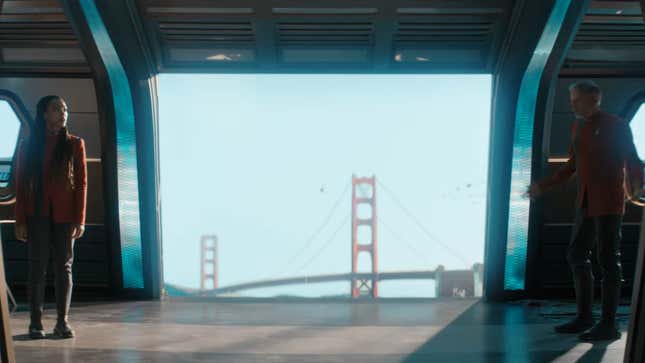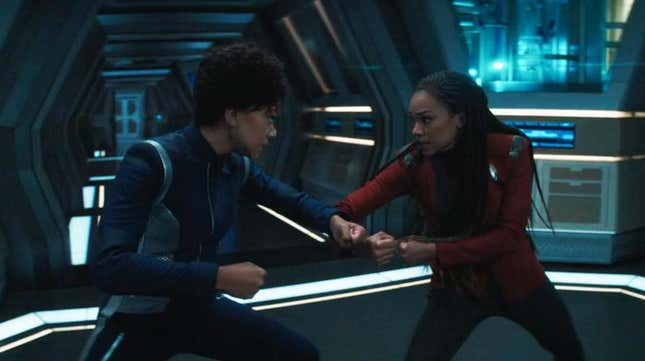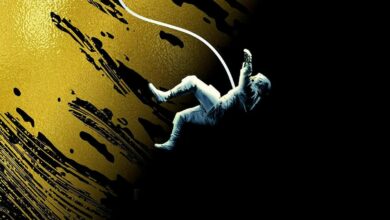Discovery Is a Time-Hopping Marvel

Star Trek: Discovery is really good with time. We knew this almost immediately when one of its earliest episodes to really wow us was “Magic to Make the Sanest Man Go Mad,” a delightful time loop caper. We knew it again, when it flung caution to the wind and catapulted itself into a future no Star Trek show had visited yet at the climax of season two. And now, as it stares down its final end, Discovery once again turns to time—and twists it, to look back on its long, strange trip.

“Face the Strange” is a deceptively simple episode on the surface, and a bold move for a show on its last lap: instead of accelerating the chase between Discovery and Moll and L’ak as they hunt for more clues to the Progenitor tech, it almost literally slams the brakes on everything to deliver a wonderful little character piece, not just for Michael Burnham, but to give time to explore Discovery’s crew, and even its newcomer in Commander Rayner, who is still struggling to adapt to Discovery’s more personable approach to hierarchy. After leaving Trill with Adira unknowingly tagged by Moll, the Discovery heads to coordinates where it expects to find the next piece of the puzzle, only to find… nothing. But what Adira was tagged with, it turns out, wasn’t a tracking device, but a “Time Bug,” a piece of Krenim technology held over from the Temporal Cold War (another great bit of using Discovery’s handling of time, in this case the passage of it, for a fun Voyager/Enterprise nod!). The Time Bug infiltrates Discovery’s systems, and locks them down—not by disabling the ship’s systems, but by trapping them in a spiraling series of time loops.
Burnham and Rayner—who were busy arguing in the ready room over Rayner’s abrasive mood—are partially unaffected by the bug’s looping, having attempted to beam back to the bridge at the precise moment it activated. While they’re caught in the same looping, being shunted backward and forward in Discovery’s timeline, they remain aware between each loop that something is wrong—and that if they don’t put aside their differences and disable the bug, Discovery will be shut down while Moll and L’ak solve the clues to the Progenitor tech and doom the galaxy (to the Breen, of all people, we learn in one of the loops!).

This is already a really fun idea, because as we previously said—Discovery knows how to do a killer time loop story already, and has known how to do that for a very long time. But what crucially sets “Face the Strange” apart from “Magic to Make the Sanest Man Go Mad” (god bless the show also toned down its love of long episode titles) is a context that the episode itself ultimately plays with: one of these episodes came just seven stories into the show’s existence. The other is the 59th, and in the time between them Discovery has done so much, changed so much, and developed in its own confidence, that it can use a similar structure and format like this again not to say “hey, look Star Trek fans, we can use the same tropes as the shows you loved,” but to instead say “hey, how do we use this trope to make a Discovery story?”
The answer is in both its characters—of course, particularly Michael—but also in the masterful way “Face the Strange” uses the concept of time looping to revisit a bunch of key moments from Discovery’s metatextual past, giving Burnham, who went through it all, and Rayner, as the newcomer, (and eventually Stamets, who thanks to the spore drive tardigrade DNA, can’t be affected by time loops—a delightfully clever nod back to “Magic to Make the Sanest Man Go Mad”!) a chance to see just how far this crew has come through and how much it’s changed them all along the way. Through Michael and Rayner’s eyes as they puzzle out the pattern of each loop, and what they need to do to stop the bug, we get to go through so much of Discovery’s past—from it being built in drydock in San Francisco, to the moment it jumped to the 32nd century, to fighting off the Emerald Chain in season three, and, most crucially, climaxing back in the early days of season one when Michael was still just a downtrodden turncoat barely given a second chance by Starfleet after the start of the Federation-Klingon war. And with that perspective, and the carried awareness from loop to loop, both Michael and Rayner alike come to understand what Discovery has been through all the better.

It’s an episode that’s perfect for a final season—standalone enough that it is also simply just a great time loop scenario, but also vitally informed by Discovery’s history over the last four seasons to deliver a really touching moment of acknowledgement for the series as it looks back on how far it’s come. It’s fun seeing the old blue metallic uniforms again, or seeing Stamets realizing that a) he’s a little worried he can quickly empty engineering of officers with a totally fake spore breach warning, or b) he used to be able to do that even quicker by being a massive asshole. It’s just as fun to see Rayner, who’s still resistant to connect to Discovery’s crew, soften as he sees everything they went through to get to where they are now, and slowly but surely use the things he’s picked up about them to his advantage. It’s both extremely fun and extremely good that, in the last time loop set during Discovery season one, we not just get to see how cold and distant the bridge crew were back then, but that Discovery finally does justice to its former cyborg crewmate, Airiam (the returning Hannah Cheesman), making her belief in Michael key to saving the day—three seasons in the making, but a far more fitting farewell to the character after her clunkily unceremonious death in season two.
But above all, “Face the Strange” is Michael’s episode, and her journey is the one examined most of all. Because if you’re going to narratively go back in time to Discovery’s first season, well, as much as she doesn’t want to, you’re going to have Present Michael face Past Michael. Sonequa Martin-Green plays the encounter to perfection: two determinedly stubborn women with things they still want to prove to both themselves and the world, pushed in each other’s faces. That it becomes a knock-down mirror match punch-up is deeply funny—fitting the aggression if Discovery’s original wartime setting while also just making it the inevitable outcome of putting two unstoppable forces in each other’s way. But Martin-Green sells just how much of a difference there is between Michael’s past and her presence in these moments with incredible charm and subtlety. The show really hammers home that while there are still things about Michael that are still Michael, the young woman petrified that she had no place aboard a starship in season one and the undeniably heroic captain of season five represent a remarkable journey the character has been on.

Crucially, however, while Burnham vs Burnham ends with her current self Vulcan neck-pinching her past self, the actual moment the day is saved is done not by Michael, but Rayner, finally learning the keys to understanding what makes the Discovery crew tick. After Past-Michael wakes up and, being so eager to prove her worth, takes the Rayner and future-Stamets on at phaser-point in Engineering as they prepare to finally destroy the Time Bug, it’s Rayner who steps in to get her to back down, making a connection—by leaning on the things Michael had told him about herself in their argument at the start of the episode—and getting Michael to see that one day she’s going to prove herself on a long, painful, but rewarding path ahead of her… if only she stops being so stubborn for a damn second and let them save the future. Even if she doesn’t remember it, it’s the exact perfect advice season one Michael needs—advice she’ll learn the hard way through Lorca’s betrayal. And in having it passed onto her from Rayner, a man who Michael herself has begun to help grow and connect to others again after all his own frustrations and hurts, really hits home just how far she’s come.
“Face the Strange” is an episode Discovery could only pull off once, as its journey comes to an end—and it does so almost perfectly, an incredibly compelling use of a time-and-tested Trek format to examine the metatextual and textual journey it’s been on these last seven years. While there’s still more adventures to go on just yet—with the Time Bug stopped, the race between Discovery and Moll and L’ak is now tighter than ever—this was a great chance to take a moment and have its heroes and the show alike take stock of how much it’s grown: and how ready it is to bid farewell.
Want more io9 news? Check out when to expect the latest Marvel, Star Wars, and Star Trek releases, what’s next for the DC Universe on film and TV, and everything you need to know about the future of Doctor Who.
Source link




